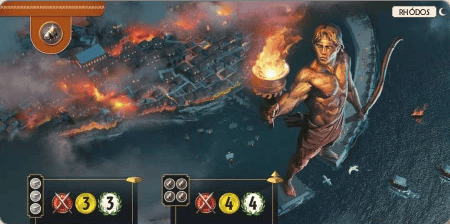
7 Wonders is a simple yet complex drafting game that requires a delicate balance of strategy, tactical maneuvering, and luck. I have recently become addicted to this game on BGA so naturally I’ve learned everything I can about how to win from online resources, other players, and trial and error in my own games.
Perhaps the thing I like most about 7 Wonders is how well-balanced of a game it is. No single strategy will win every time, and with many varied civilizations to choose from each game takes on a different flavor. I’ll dive deep into some of the more advanced strategies and scoring nuances that I’ve learned so that you can apply them to your own games. I’d also recommend that you check my other posts about 7 Wonders here:
- 7 Wonders: Strategy Guide to Win as a Beginner (11 Tips)
- 7 Wonders: How to Win With Every Wonder (Both Sides)
Adjust your strategy to the number of players
7 Wonders can be played with 3 to 7 players, and it’s important that you adapt your play style to your game’s player count. The size of the card decks is adjusted to accommodate the size of the game, and the distribution of the cards varies with the player count. While most of the strategies I will outline in this post apply to all player counts, you need to keep this fact in mind so that you can make the necessary adjustments.
Economic Implications of Various Player Counts
The distribution of basic resources (brown cards) and manufactured resources (gray cards) changes significantly depending on the number of players in the game. Take just a minute to look at the charts below. They show the number of resource cards and the total number of resources available per player at each player count.
| # of Players | # of Cards | Cards/Player | # of Resources | Resources/Player |
|---|---|---|---|---|
| 3 | 11 | 3.7 | 17 | 5.7 |
| 4 | 18 | 4.5 | 29 | 7.7 |
| 5 | 22 | 4.4 | 34 | 6.8 |
| 6 | 25 | 4.2 | 39 | 6.5 |
| 7 | 25 | 3.6 | 39 | 5.6 |
| # of Players | # of Resources | Resources/Player |
|---|---|---|
| 3 | 7 | 2.3 |
| 4 | 7 | 1.8 |
| 5 | 10 | 2 |
| 6 | 14 | 2.3 |
| 7 | 15 | 2.1 |
The takeaway here is that in 3 and 7-player games, basic resources (brown cards) are much more scarce than they are in 4, 5, and 6-player games, with 4-player games featuring the most by far. The opposite is true for manufactured goods (gray cards), where 4-player games have the least amount of resources available to each player while 3, 5, and 7-player games have more. So what does this mean?
| # of Players | Basic Resources | Manufactured Resources |
|---|---|---|
| 3 | Most Important (Most Scarce) | Least Important (Most Abundant) |
| 4 | Least Important (Most Abundant) | Most Important (Most Scarce) |
| 5 | Moderately Important | Moderately Important |
| 6 | Moderately Important | Least Important (Most Abundant) |
| 7 | Most Important (Most Scarce) | Least Important (Most Abundant) |
Note that this is all relative – resources are vital to success at any player count. But if, for example, you’re in a 4-player game and you’re on the fence about player a brown resource card or something else that seems equally useful, it would likely be best to go with the other card because those resources tend to be more prevalent in 4-player games.
Military Implications of Various Player Counts
One of the most glaring differences between low and high player count games is the impact of military conflict. Since your military cards are only ever compared to the players directly adjacent to you, the impact of your military becomes less and less impactful the more players you add.
In a 3-player game, you will always be in direct conflict with all of your opponents so there is a lot of value to be gained by having a superior military. However, in a 6 or 7-player game, those military points you score don’t come at the expense of many of your other opponents. They may be focusing on scoring in other ways that are much more efficient and you’ll end up losing to them because of the opportunity cost of playing Military cards.
I’ll go into the math of Military scoring later in this article, but for now, just keep in mind that the effectiveness of Military cards is inversely proportional to the number of players in the game.
Let your Wonder guide your play

One of the beautiful things about 7 Wonders is the subtle but important differences between each civilization’s Wonder Boards. You can have success with most strategies with almost any Wonder Board, but the easiest path to victory usually involves using the unique abilities made available by your Wonder’s abilities and resources.
I have an entire post about the intricacies of playing each Wonder but, in general, you should let your Wonder help dictate your overall strategy. Does your Wonder have a Science bonus? Consider going heavy on Science to make use of it. Does it grant extra resources? You can probably go lighter on resource cards and focus on other areas instead. These decisions can have a huge impact on the game, and whoever makes the best use of their Wonder’s abilities is often going to win.
DID YOU KNOW? You can find many exciting expansions for 7 Wonders on Amazon that bring a fresh experience to the game:
Aim to score 60 or more points to win
In my experience, it usually takes a score of 60 points or higher to win a game of 7 Wonders. This is just a general benchmark because I have won games with scores in the 40’s and lost games with scores in the 70’s. The winning score can vary considerably based on many factors including:
- The total number of players
- The amount of hate drafting being done
- The distribution of resources among players
- Synergy of Guild and other cards
- Pure luck
I like to keep the goal of 60 in mind because it seems to be the sweet spot for most games. Use it as a guide to help keep you on track as the game progresses. For reference, I looked at the data from BGA to see what the top players usually score and what the average winning score for all games is (see the table below). Keep in mind that the average scores of top players also include games that they lost.
| Average Winner | Top Player #1 | Top Player #2 | Top Player #3 | |
|---|---|---|---|---|
| Average Score | 60.6 | 58.1 | 56.7 | 55.6 |
Score with multiple structure types
Winning a game of 7 Wonders requires that you score well with multiple structure types (card colors). Not all cards score points directly, but every card you play should be with one or more of the following goals in mind:
- Scoring points immediately
- Scoring points in the future
- Denying points to your opponents
There are 7 different ways to score in 7 Wonders (coincidence?) – 5 different card colors, currency, and directly from your Wonder. A well-balanced approach to scoring that eventually focuses on just 2 or 3 scoring mechanisms is usually the way to go, but every game plays out differently. Below are the average scores in each category for top players on BGA and the average of all players.
| Point Statistic | Average Player | Top Player #1 | Top Player #2 | Top Player #3 |
|---|---|---|---|---|
| Military | 5.5 | 8.57 | 10.1 | 6.0 |
| Civilian | 13.5 | 17.0 | 14.7 | 12.9 |
| Scientific | 10.9 | 7.6 | 8.7 | 14.0 |
| Commercial | 3.2 | 4.4 | 3.9 | 3.5 |
| Giuld | 7.2 | 8.5 | 8.0 | 8.9 |
| Wonder | 7.4 | 7.7 | 7.3 | 7.4 |
| Currency | 4.3 | 4.4 | 4.1 | 3.4 |
| TOTAL | 52.0 | 58.1 | 56.7 | 55.6 |
Clearly, scoring in a variety of ways is important (and virtually inevitable). Every player has their own play style (Top Player #3 obviously likes to focus on Science, for example), but it’s always important to score points from a variety of sources.
Understanding how each one works and remaining open to all scoring methods is essential if you want to improve your game. I’ll go into the mechanics of each scoring mechanism and when you might want to focus on them.
Military
The most points you can possibly score from Military in a game of 17 Wonders is 18, while the fewest you can score is -6. On a points-per-card basis, this can either be very good or horribly inefficient, depending on how many Military card you’ve played throughout the game.
If you can score all 18 points by only playing 3 Military cards, that’s a terrific 6 points per card. However, if you get drawn into an arms race with your neighbors it’s usually a losing proposition. If you manage to score all 18 points but you had to play 6 Military cards to do so, you’re only getting a measly 3 points per card – meaning another player will almost assuredly outscore you in the end.

Military is most valuable in 3 player games because you’re in direct competition with all of the other players in the game for those points. At higher player counts, a few players might get into an arms race and compete with each other while the rest of the table is racking up points in more efficient ways.
One strategy I like to use if I’ve neglected my Military for most of the game is to do a last-minute buildup in Age 3. If I have 0 Military and the player I’m passing to only has 1 or 2, I can play an Age 3 Military card toward the end of the round to take the lead on him. Then, I can use any additional Military cards that are passed to me to complete my Wonder or simply play it myself. This leaves my opponent with no way to regain the upper hand on me, militarily.
Civilian
Scoring points with Civilian structures is straightforward and reliable. The number of points they’re worth is clearly printed on the card and it doesn’t change no matter what you or your opponents do. When in doubt, scoring with Civilian structures is always a solid choice. You’ll usually be getting pretty good (but usually not the best) value by playing one, and they serve as a good baseline for the value you should be looking for from other cards during any given age.
The most complicated aspect of Civilian structures is their ‘chaining’ effect which allows you to build other Civilian structures for free in later Ages. This effect, while nice, is rarely worth considering in a card’s value in my experience since you’ll usually have the resources required to build the subsequent structures, anyway. This is especially true of Theater which allows you to build Gardens for free in Age 3. Gardens is only worth 5 points and has a low cost, anyway. Ideally you should be aiming to score more than 5 points per card in Age 3, and if you need to play Gardens you’ll almost assuredly be able to play it even without the chain effect from Theater.
Science
Science is, by far, the most complicated and misunderstood scoring mechanic in 7 Wonders. Many new players think it’s overpowered since it’s fairly common to see one player hoover up all of the Science cards and score a ridiculous amount of points with them. While this does certainly happen, it’s also relatively easy for other players to counter.
I have been assuming that you know the rules for the game, but the scoring for Science cards bears repeating. You score N*N points for every ‘N’ Science cards you have of a specific type, and 7 points for each complete set of the three different types of Science cards (Gears, Tablets, and Compasses).
Unlike other scoring methods, if you want to score well with Science it’s critical that you commit to it early. Every Science card you collect tends to be more and more valuable than the ones before, so it’s important to get an early start.
In order to make a Science strategy work, you should aim to have at least 2 of each symbol. This is worth 26 points by itself, for an average of 4.3 points/card. If other players fail to counter your strategy you can sometimes get 3 of each symbol which is worth a whopping 48 points – an average of 5.3 points/card. You can tack on even more points with the Science Guild in Age 3 or if your Wonder grants an Science bonus.
The danger of a Science-heavy strategy is that other players are likely to sniff it out early and work to counter it by denying Science cards to you. They may draft some Science cards themselves, use them to build their Wonder, or even sell them for gold. This can really put you in a bind if you’ve neglected your resource engine and gone all-in on Science because you won’t be able to easily pivot to other point-scoring mechanisms.
Commercial
Commercial structures generally don’t score a lot of points themselves, but they can be some of the most valuable cards in the game if utilized correctly. They can provide a flexible pools of resources, give you discounts on resources from other players, and grant you gold or points based on other structures in your or your opponents’ civilizations.
In my opinion, the Marketplace and Trading Post cards are some of the most valuable Age 1 cards in the game. Not only do they give you a discount on resources from your neighbors, but they give you a chance to chain build Caravansery and Forum in Age 2. These cards provide an incredible amount of flexibility that meshes well with almost any other strategy.
Commercial cards are particularly valuable if you’re going heavy on Science. Forum, in particular, ensures that you will always have access to the manufactured goods you’ll need to purchase Science cards. Similarly, Caravansery is a quick way to diversify your resource pool without having to spend a lot of time drafting specific Basic Resource cards, allowing you to draft more Science cards instead.
Guild
Guild cards are some of the most powerful point-scoring cards in the game, with the potential to score much more than any other single cards. Many games of 7 Wonders come down to who can buy just the right Guild cards in Age 3.
In general, you can score very well with Guild cards if:
- You have the resources to pay for them
- You have a well-diversified civilization and a complete Wonder
- Your opponents have specialized in one or two colors
If you have built a well-rounded civilization with plenty of brown and gray resource cards and a complete Wonder you should try to score big with cards like Decorators Guild, Shipowner’s Guild, and Builder’s Guild. If your opponents have gone hard on a specific structure type then you should try to snatch up the Guild cards that make use of that. For example, if both of the players you’re adjacent to have built up a lot of Military cards then you should consider buying Spies Guild.
Don’t forget to factor in the potential future points Guild card can score for you. If an opponent is going all Science, you can be sure that they’ll keep playing more Science cards throughout Age 3. You can play Philosopher’s Guild and be confident that it will end up being worth more points than it is initially.
Since Guild cards can be so powerful, you should also heavily consider denying them to your opponents by using them to complete your Wonder. If an opponent is racking up Science cards then I will often choose to use Scientists Guild to complete my Wonder just to deprive my opponent.
You should also keep in mind that Guilds become harder to acquire in games with high player counts because they are spread between more players. You should try to memorize the cost of each Guild card so that you can make sure you’ll be able to buy a critical Guild card if and when it comes around to you.
Wonder
Scoring with your Wonder is fairly straightforward, but not all Wonder boards are built the same. I’ll go into how to best utilize each Wonder board later in this post, but in general, you should aim to complete one phase of your Wonder in each Age. There are plenty of exceptions to this, but if you’re new to the game it’s a good rule of thumb.

Remember that a big part of the value your Wonder can provide is that it’s an option to use when no cards in the hand seem particularly useful. It’s nice to have a Wonder slot available at the end of Age 3 in case the last two cards passed to you are otherwise useful.
Currency
Ideally, you will score few or no points with the currency you have left at the end of the game. You get a measly 1 point for every 3 coins you have in your bank. In a perfect game, you would have used most or all of your coins to play cards that offer a better return than that.
Still, it’s not uncommon for coins to make all the difference at the end of a game. If you end up with a big stockpile of coins (think 20+) that adds up to quite a few points. Plus, if the game ends in a tie you will likely win the tiebreaker since it’s unlikely anyone else has that much currency on them.
Thanks for reading! If you’re a fan of 7 Wonders Duel and 7 Wonders Architects, I have your strategy guides covered there, too!
- 7 Wonders Duel: Strategy Guide to Win More Often (11 Tips)
- 7 Wonders Architects: Ultimate Strategy Guide (12 Tips)
Thanks for reading! If I missed something or you have your own opinions, please drop a comment below.
What is thr benefit of along out first in hand? Seems to me like you would never want to assume…
Your strategy comments are excellent, well thought out and very helpful! Thank you
You would only get to draw and play a Sanctuary card on turn two of round one if the Region…
Rule question. If in phase one of round one I play a Region card with a Clue symbol at the…

Leave a Reply